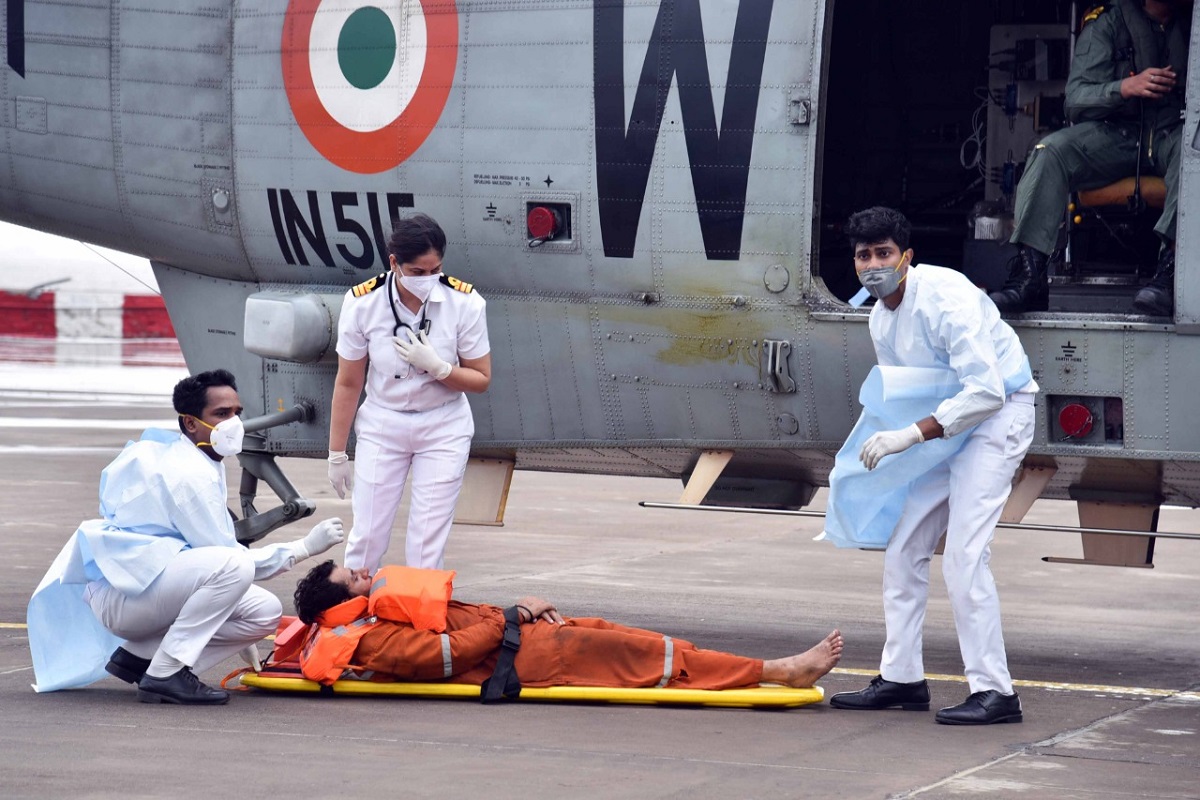As multiple commercial vessels raised distress calls in the wake of Cyclone Tauktae lately, which ravaged the Western coast of India and finally made landfall on the Gujarat coast last Monday, the Indian Navy which was already standby to provide help, deployed a number of its frontline assets to provide immediate assistance.
The incident, following the sinking of barge P-305 on the same day, with 261 persons onboard, led to one of the biggest co-ordinated Search and Rescue (SAR) operations off the coast of Mumbai. The operations, still ongoing, were conducted in some of the most difficult conditions possible. The immense quantum of risk being taken, made possible by the sheer audacity and fortitude of our Navy’s personnel, has resulted in 188 souls being saved, with the efforts to rescue any remaining survivors continuing unabated.
Advertisement
What makes this operation so incredible? The ships were initially deployed in stormy seas, with 140 kmph winds and 8-9-metre-tall waves. Normally, in such weather, the ship’s upper decks – which are exposed to the sea and weather, routinely get covered or ‘swamped’ by the towering waves, even while the visibility drops to zero. The ships themselves roll up to 30-35 degrees, making any movement onboard a risky proposition. As a standard procedure, all personnel are kept inside the ship’s structure, and no one is allowed to go outside. In limited cases, personnel do venture out, with comprehensive safety gear and procedures, and for minimal times, to undertake emergency repairs or checks.
In contrast, during the early stages of the SAR operations on 17-18 May, the crews of Navy’s destroyers stood strong and alert on deck, braving these conditions, keeping a continuous lookout for survivors, even as the ships were tossed around by the angry seas. Each person onboard played a vital role, working seamlessly and tirelessly, to keep the mission going. While the engineers and technicians ensured that the equipment and machinery kept working and damage was minimal, the operations crew prepared innovative means to undertake retrieval of the survivors. Medical and logistics staff rapidly prepared to meet the requirements of the survivors, continuing to work in hazardous conditions, to cater for any eventuality.
The professional competence of the naval officers and navigational team was underscored as the ships reached the distress location within a few hours and were thereafter carefully manoeuvred and positioned with exactitude, to enable quick and safe recovery of the survivors. The teams on deck, which were charged with getting the survivors onto the ship, worked fearlessly and confidently, to safely get people out of the water. All this happened in conditions, where it is difficult to hear one’s own thoughts and nearly impossible to stand upright! Survival at sea becomes more challenging with each passing minute, and the quick and effective response by the entire Naval organisation was instrumental in quick rescue of such a large proportion of the survivors.
Coordination between various echelons of the Service, from the Maritime Operations Centres in Mumbai and New Delhi, Naval aircraft flying from Arakkonam and Goa, as well as among the multiple ships and aircraft at sea, enabled successful recovery of the majority of the persons from the ill-fated barge. In addition, information received from other agencies at IMAC, Gurgaon as well as the Joint Operations Centre, Mumbai was rapidly processed and relayed to all units engaged in the operation.
The commitment of the Navy to safety of life at sea was further reinforced when helicopter operations were commenced as soon as weather improved marginally. Sea King Helicopters, modified for rescue operations, were deployed to recover dispersed survivors, in conditions which make even normal flying a challenge. Divers were lowered into the water from these helicopters, to grab onto survivors and get them winched up to safety. The minimal separation of the helicopter from the sea, with high waves, required very highly skilled flying as well as nerves of steel. Multiple successful rescues of this nature were undertaken as the Navy intensified the effort. These operations resulted in successful rescue of 35 survivors of barge GAL Constructor off Mumbai. Subsequent joint operations by the Navy and Coast Guard ensured that all 137 crew of this barge were safely rescued. A similar operation was also undertaken by a Naval ALH off New Mangalore on 17 May, to rescue the distressed crew of tug Coromandel Supporter XI.
In summary, naval personnel and assets were deployed throughout the affected parts of the west coast, from Mangalore to Gujarat, to provide timely and meaningful assistance. For sailors across the world, saving lives at sea is a common and holy duty. When the Indian Navy was called upon, and lives were imperilled at sea, each and every member of the Service stood up to the occasion. The professional excellence, grit, tenacity, and fearlessness demonstrated by the ships and aircraft engaged in the SAR mission, embodies the lofty standards which the entire Indian Navy embraces.
The Indian Navy has always, willingly, and confidently, ventured into the storm to protect the country and their countrymen, from any danger. Naval personnel, across ships, aircraft and bases have repeatedly risen to the occasion and contributed positively to overcome any challenge which the nation is facing. A young seaman from the destroyer Kolkata, before sailing out for the rescue mission, reportedly said this to his family – “we will go and save our friends from the storm now, and once we return safely, we will continue our battle against COVID”. Such positive spirit among the crews truly reflects the Navy’s commitment to its pledge – Har Kaam Desh ke Naam.
This operation will always be etched in the annals of history and will continue to reinforce the sacred and timeless covenant – of saving lives at sea – shared by seafarers across the world. Shano Varuna!
(The author is a Delhi-based, DCC qualified, defence beat writer and independent contributor to print and online publications)











